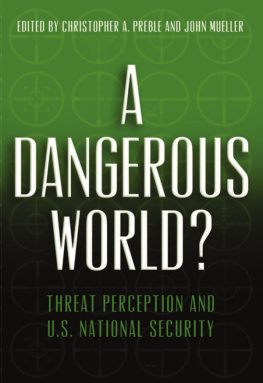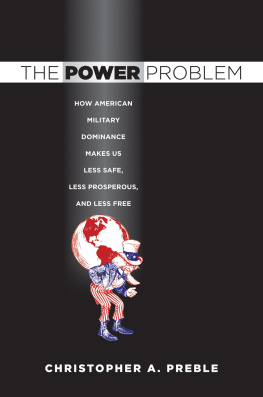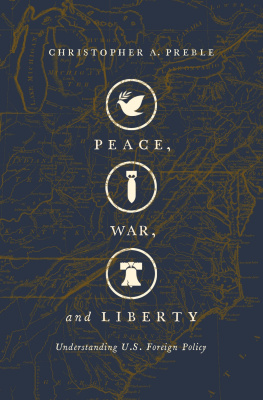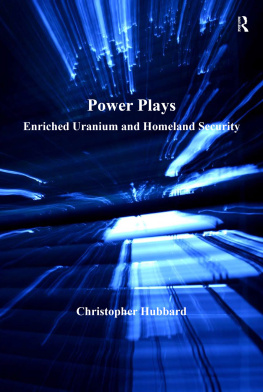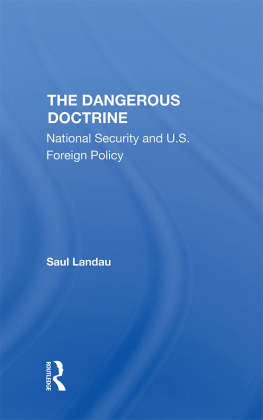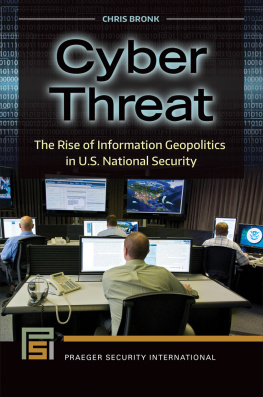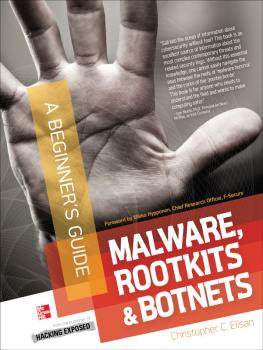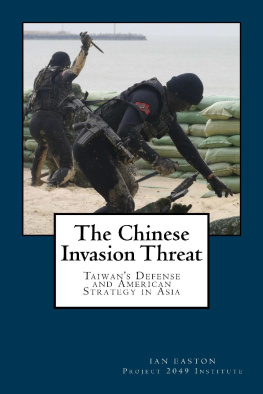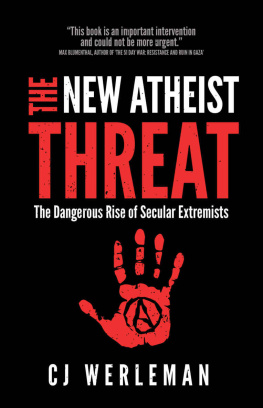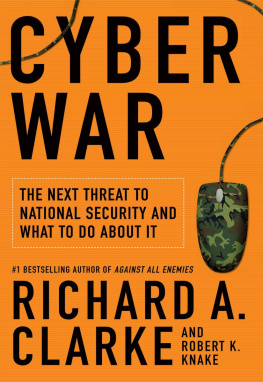Copyright 2014 by the Cato Institute.
All rights reserved. For information about reprint permissions, please contact Cato Institute, 1000
Massachusetts Ave., NW, Washington, DC 20001.
Published by Cato Institute Press.
Library of Congress Cataloging-in-Publication Data
A dangerous world? : threat perception and U.S. national security / edited by
Christopher Preble and John Mueller.
pages cm.
Includes bibliographical references.
ISBN 978-1-939709-40-0 (paperback : alk. paper)
1. National securityUnited States. 2. ThreatsUnited States. I. Preble,
Christopher A., editor. II. Mueller, John, 1937- editor. III. Title: Threat perception and
U.S. national security.
UA23.D25 2014
355.033073--dc23
2014028682
eISBN 978-1-939709-41-7
Cover design: Jon Meyers
www.cato.org
In February 2012, General Martin Dempsey, the chairman of the Joint Chiefs of Staff, explained, I cant impress upon you that in my personal military judgment, formed over 38 years, we are living in the most dangerous time in my lifetime, right now.
He is scarcely aloneor unusual. Director of National Intelligence James Clapper, born in 1941, has testified that he has never experienced a time when weve been beset by more crises and threats around the globe.
Such extravagant proclamations occasionally do generate some pushback. However, for the most part, the alarmist pronouncements go rather blandly accepted and uncountered. The Defense Departments Threat Reduction Agency never seems to come out with reports observing that there may not be, actually, all that many threats out there to reduce.
One could say that fear and anxiety are baked into our DNA. Our distant ancestors correctly perceived that a four-legged creature charging at them from a distance might be dangerous, and they were impelled by such emotions either to flee or to defend themselves. Thus, they lived to procreate. But getting the threats right is important. Unnecessary and excessive fear can be harmful to health and emotional well-being. Indeed, fully 18 percent of Americans already
The unkind might be inclined to suggest that General Dempsey and the many politicians and administrators who agree with his alarmism are motivated by political or institutional self-interest. However, it is highly important to evaluate their proclamations carefully. Do we live in a world that is uniquely or especially dangerous? From wars between states to wars within them, from crime and terrorism to climate change and cybermischief, we are beset by a seemingly endless array of threats and dangers. But is it possible that there is something to Menckens quip? Are many or most of the threats so prominently espied and promoted imaginary? This book seeks to carry out that task of evaluation.
The contributors ask to what degree, if any, the United States is actually threatened. Most of them argue thatfrom the standpoint of American national securitythe world is safe and growing safer and that Americans enjoy a measure of security that our ancestors would envy and that many of our contemporaries do envy.
They approach that question from different angles, considering both the multiplicity of supposed threats and the wisdom or folly of the measures proposed to deal with them. They seek to put todays perceived threats and dangers in full context and consider as well those that no longer loom. Together, they chip away at the common perception that U.S. national security is severely threatened and getting worse.
The book begins with the two chapters about nuclear weapons. It examines fears that such weapons could fall into the hands of terrorists or other nonstate actorsor that ever more countries will acquire them.
In his chapter, Francis Gavin shows that such fears are not new and muses over the paradox that, although the threat of nuclear catastrophe has decreased enormously, alarmism about nuclear weapons persists. Some of this alarmism, he suggests, has been impelled by the fact that the United States has been concerned that the proliferation of such weapons might limit its own ambitions. He hopes that a better understanding of the history surrounding the weaponsincluding the impact that they have had on international relationsmight produce better policy and calm public and official fears.
John Mueller agrees. Fears of rampant nuclear proliferation ignore the fact that most countries have never seriously aspired to possess such weapons, as well as that those countries that have taken them on have found them to be more trouble than they are worth. Moreover, the effects of the proliferation that has taken place have been substantially benign: possessors have used the weapons simply to stoke their egos and to deter real or imagined threats. However, aggressive attempts to stop proliferation have resulted in the deaths of tens or hundreds of thousands. Meanwhile, terrorist and other nonstate actors have exhibited only limited desire to attain a nuclear capacity, and they will confront monumental difficulties if they try to do so.
For many, the single greatest state-based threat emanates from Chinaa country of sufficient size and potential wealth to directly challenge the United States in the future. Lyle Goldstein is sensitive to such concerns, and he considers some of the specifics of Chinas military modernization, as well as the potential geopolitical flashpoints that could, in worst-case scenarios, lead to war. On balance, Goldstein suggests that U.S. policymakers reaction to Chinas emergence as a global threat is premature and may prove counterproductive. Rather than seeking excuses to contain Chinas rise on the assumption that such a rise will inevitably lead to conflict, Goldstein urges the United States instead to exploit opportunities for collaboration and cooperation. Any actual threat from China is minimal, he argues. Although there are insecurities and problems, China is neither out to attack the United States nor out to conquer East Asia, and any risks can be mitigated quite easily with appropriate hedging policies. Indeed, to the extent that legitimate dangers exist in the world, the two countries have many reasons to work together to reduce or eliminate them.
Three chapters consider nonstate and substate threats around the world including terrorism, insurgency, revolution, rebellion, crime, and general disorder.
Paul Pillar observes that these threats pale in comparison to traditional state threats, and he urges readers to reexamine their preconceived notions of what is required to keep the United States both safe and free. He voices dismay at the tendency to espy monsters abroad and then to conceive of Americas place in the world largely as one of confrontation against them. Noting a disconnect between how much alarm substate conflicts abroad often generate and how much danger they actually pose to U.S. interests, Pillar examines three varieties: the potential overthrow of a friendly regime, direct threats to the United States by substate groups, and trouble stemming from internal disorder itself. He cautions that the capacity of the United States to curb substate conflict is usually very limited and that intervention can often prove to be counterproductive or otherwise damaging.


